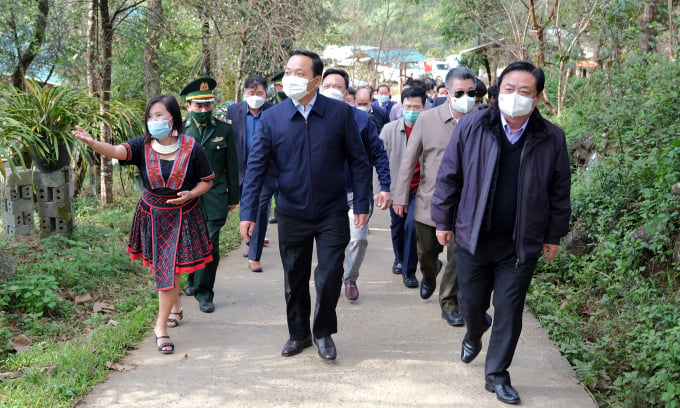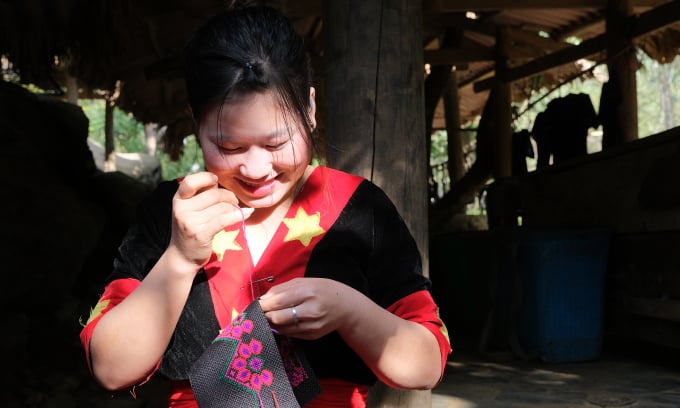May 31, 2025 | 14:01 GMT +7
May 31, 2025 | 14:01 GMT +7
Hotline: 0913.378.918
May 31, 2025 | 14:01 GMT +7
Hotline: 0913.378.918

Minister of Agriculture and Rural Development Le Minh Hoan and Chairman of Lai Chau People's Committee Tran Tien Dung visited Sin Suoi Ho village, December 2021. Photo: Bao Thang.
Situated at an altitude of 1,500m above sea level, Sin Suoi Ho in H’mong language means "the golden stream". More than 30km from Lai Chau city, is surrounded by a primeval forest, the village is currently a bright spot in the development of the model of community-based tourism and agroecology in Lai Chau.
Situated at an altitude of 1,500m above sea level, Sin Suoi Ho village is clothed in a primeval forest. Having its name bearing another meaning - "the golden stream" - in H’mong language, the village is indeed a bright spot in this new movement of developing community-based tourism and agroecology models in Lai Chau.
Sin Suoi Ho is only over 30km far from the main city of Lai Chau. Upon arrival tourists can't help but be surprised to see with their own eyes the wooden houses and rammed earth houses with signature features of H’mong people’s architecture.
What makes these houses unique is the hand-folded stone fence surrounding the house, only up to half a person's height. This structure both creates solidity for the house as well as the ability to be cool in summer and warm in winter. Many houses are also adorned with pots of cymbidium bigger than an adult hug.
Sin Suoi Ho also attracts tourists through its cultural festivals. The most spectacular is H’mong people’s biggest Gau Tao Festival of the year which is held from the 3rd to the 6th of January every year. At this festival, tourists can participate in attractive folk games such as Pao throwing, stick pushing, tug of war, and Tu lu fight. The village also organizes some other festivals such as New Rice Festival and Meo Cabbage Festival.
A special surprise for tourists is they can almost see no one here working on farms. Most of the H’mong women focus more on weaving traditional clothes from linen and preserving the unique technique of beeswax painting on cloth that has been passed down through generations. They also do brocade embroidery, knitting, and wine making which helps bring a stable income many times higher than farming.
Seeing people's lives firsthand, as well as visiting homestay services and the pigs, chickens and vegetable models, Minister Le Minh Hoan said with certainty that Sin Suoi Ho is one of the prime examples of new rural development. He also told Mr. Vang A Chinh, Head of Sin Suoi Ho village, to focus on replicating indigenous cymbidium in combination with local trees such as peaches and apples to further promote tourism.

A H’mong girl in Sin Suoi Ho. Photo: Bao Thang.
At first, people in the village did not think much of tourism. They only cared about farming, growing herbs and fruits. thanks to the local authorities’ training, information and guidance on the development of community tourism, people's lives in the village gradually changed. Many people have built motels and homestays specializing in welcoming tourists. Since being recognized as a community tourism village in 2015, Sin Suoi Ho receives approximately 100,000 domestic and foreign tourists each year.
Mr. Vang A Chinh, Sin Suoi Ho village head

The welcome gates of each homestay in Sin Suoi Ho village possess their own distinct and unique style. Photo: Bao Thang.
From being a poor village, after nearly 20 years, households in Sin Suoi HO now make a fortune from tourism and selling a variety of local products such as cymbidium, cardamom, docynia, brocade or rattan and bamboo woven handicraft.
Compared with other tourist development sites, the model in Sin Suoi Ho has many new points. They follow the principle of "people work - people enjoy". Tourism here is associated with creating livelihoods for local people. Tourism models are imbued with culture and national identity. All of these factors result in a driving force for sustainable economic development.
Blessed with favorable climate conditions, Sin Suoi Ho is now reaching out to become a grand domain of cymbidium in the Northwest region. Many families in the village have significantly increased their income thanks to growing and selling cymbidium to tourists. Up to the present date 100% of households in the village have grown cymbidium. Some houses have a few dozen pots at least, some houses may have more, even up to 500 - 600 pots.
"Each household here earns VND 30 - 50 million/year on average thanks to growing cymbidium. Households who both provide homestay services and grow cymbidium can earn up to VND 200-300 million/year,” said Mr. Vang A Giang, owner of a cymbidium garden in Sin Suoi Ho.
Translated by Samuel Pham

(VAN) Several scientists and farmers are experimenting with soil treatment in some key durian-growing regions such as Cai Lay (Tien Giang), Dak Song, Gia Nghia, and Dak R’lap (Dak Nong).
/2025/05/25/4127-3-073637_820.jpg)
(VAN) Thanks to the promotion from an FAO-implemented project, vegetable production in greenhouses in Moc Chau has seen strong development, from 1.5 hectares in 2021 to nearly 50 hectares in 2024.

(VAN) FAO has recently supported USD 140,000 to implement the project 'Risk mitigation human-animal interface risks through disease control initiatives in pig farming.'

(VAN) The People's Committee of Tra Vinh province has approved an adjustment to the investment policy for the Green Hydrogen Plant project, increasing its area to approximately 52.76 hectares.
![Reducing emissions from rice fields: [2] Farmers’ commitment to the soil](https://t.ex-cdn.com/nongnghiepmoitruong.vn/608w/files/news/2025/05/05/dsc08881jpg-nongnghiep-140632.jpg)
(VAN) Clean rice cultivation model in Thuong Tan commune, Bac Tan Uyen district, is assisting local residents in achieving sustainable agriculture by substantially reducing costs, increasing productivity, and protecting the environment.

(VAN) At the conference to disseminate Resolution No. 68, AgriS introduced its digital agricultural ecosystem and reaffirmed its commitment to accompanying the Government in promoting private sector development and sustainable agriculture.

(VAN) 'Blue Ocean - Blue Foods' initiative is designed to restore marine ecosystems and establish sustainable livelihoods for local communities by cultivating a minimum of 1,000 hectares of cottonii seaweed in the first three years.